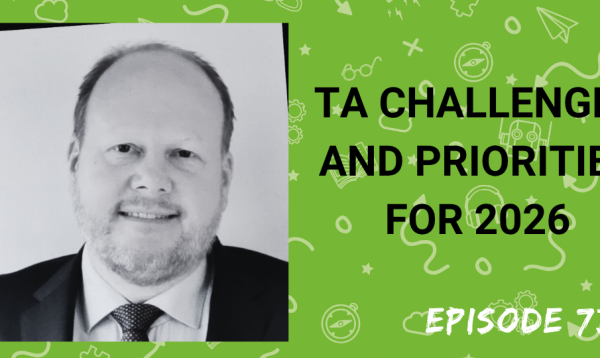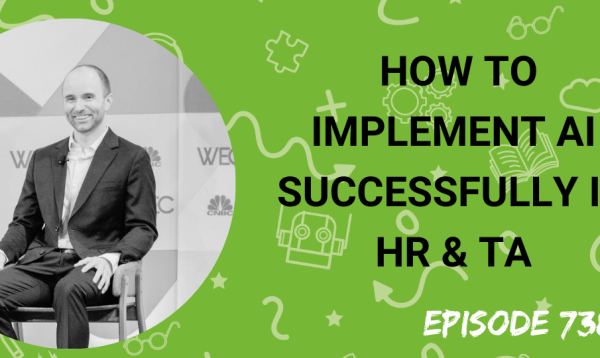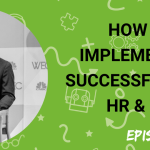One of the most talked about areas of HR and Recruiting is People Analytics. But why is it such a popular trend and, in practical terms, what does People Analytics actually even mean?
I can think of no one better qualified to answer these questions than David Green, Global Director of People Analytics Solutions at IBM and one of the world’s leading commentators on this topic. I’m delighted to have David as my guest on the show this week.
In the interview we discuss:
• David’s definition of People Analytics
• The difference between analytics and reporting
• Specific use cases of People Analytics across the talent lifecycle
• Why recruiting is such a good fit for People Analytics
• Predicting the future with Predictive Analytics
• Internal and external data sources
• AI and why we should believe some of the hype
David also shares his views on using analytics to improve the employee experience and gives us his predictions for the future of this space
P.S. My new book “Exceptional Talent” is available now. You can buy copies here directly from Kogan Page the publisher and if you use discount code FHRET20 you’ll get 20% off.
If you want to subscribe to the Exceptional Talent mailing list to be kept updated on addition content and workshops we will be developing you can do that here www.exceptionaltalent.io
Subscribe to this podcast in iTunes
Transcript:
Matt Alder [00:00:00]:
The podcast this week is supported by Workshape IO, the revolutionary hiring platform for companies looking to recruit software engineers. Forget about searching databases or publishing job ads which never get read. Workshape IO instantly builds relevant pipelines by algorithmically matching compatible software engineers to the job you’re hiring for. It’s simple, direct and honest. With Workshape IO, you can go from registration to conversation with a relevant developer in less than five minutes. If hiring software people is on your agenda in 2017, you can check out the platform at www.workshape IO.
Matt Alder [00:01:02]:
Hi everyone, this is Matt Alder.
Matt Alder [00:01:04]:
Welcome to episode 91 of the Recruiting Future podcast. It’s increasingly obvious that one of the most talked about areas of HR and recruiting is people analytics. But why is it such a trend at the moment? And in practical terms, what does people analytics actually even mean? I can think of no one better qualified to answer these questions than David Green, Global Director of People Analytics Solutions at IBM and one of the world’s leading commentators on this topic. I’m delighted to welcome David as my guest on the show this week, and I know you’ll find his insights fascinating. Hi, David, and welcome to the podcast.
David Green [00:01:47]:
Hi, Matt, and thank you for having me.
Matt Alder [00:01:49]:
Absolute pleasure. Can you introduce yourself and tell everyone a bit about who you are and what you do?
David Green [00:01:55]:
Yeah. Hi everybody. So my name’s David Green. I have a very grand title, but it’s not as grand as it sounds. Global Director of People Analytics Solutions at IBM. And that essentially gives three strands to that role, really. So the primary one is that I’m fortunate to be able to write and speak globally on people analytics, data driven HR and the future of work. And effectively, what I’m trying to do there is shine a light on. On great work that’s being done by practitioners around the world, also some vendors, but also shine a light on some of the best practice in the space from organizations that are kind of forging ahead with people analytics. The second strand is I work with IBM customers to help shape and develop their people analytics journeys, which are increasingly incorporating things around employee experience and artificial intelligence. And then the third part, I’m also part of the IBM Smarter Workforce Institute, which is our research team, and we publish probably four to five studies year on areas around the future of work, people analytics and employee experience. We have published other stuff as well around assessments and talent acquisition, but it’s all with a. With A future lens on trends that are happening and trying to interpret those and provide some advice for people in this space.
Matt Alder [00:03:09]:
Now, in the last few years, we’ve kind of seen a massive increase in the amount of discussion of people analytics people kind of putting these things into practice and lots of debate in this area. But I’m sure because there has been sort of such a rapid. A rapid rise in them, there will be people who still don’t completely understand what we mean by people analytics. Could you give us a bit of a definition and perhaps tell us why they’re becoming so important?
David Green [00:03:40]:
Yeah, I think there’s still more talk than doing at the moment. There are studies out there, IBM have published after Deloitte that say somewhere between 12 and 15% of organizations are actually doing analytics with their people data. I think it’s probably less than that. I’m sure the organizations that we sample are bigger organizations, shall we say. So in terms of a definition, I think the first thing to say is do not confuse analytics with reporting. They are different. So reporting kind of tells you what has happened, analytics can tell you why it has happened, and predictive analytics can tell you maybe what will happen. So there are differences there. So in terms of a definition, it’s one I use. I’ve kind of molded together something that the Wharton School have got on their people analytics course. But she’s on Coursera, which I definitely recommend to those that are interested in getting a kind of taster into what this area is about. And also one that we from our Smarter Workforce Institute research paper on starting the workforce analytics journey. So, you know, I say the use of data and analytics tools to identify insights on people that enable faster, more accurate and more confident business decision making. And for me, it’s all about making better business decisions. It’s as simple as that, really.
Matt Alder [00:05:04]:
Could you give us maybe some kind of examples of some specific areas that people are measuring and analyzing using people analytics?
David Green [00:05:15]:
I think they’re working across the whole talent lifecycle map. But I’d say that most companies get started with attrition because, let’s be honest, that’s a problem in most organizations, particularly when you segment it down into areas such as business, critical talent, maybe high potentials, high performers, et cetera. Most organizations have a problem in that area. It’s also easier to quantify what the return on investment might be as well. And I’d say the other area where a lot of work has been done and where people tend to start is around recruiting. So that is predicting, you know, who’s going to be a good hire and who isn’t going to be a good hire? I’d say those are the two areas where I’d say people tend to get started.
Matt Alder [00:06:03]:
So I’m going to ask you a bit more about recruiting in a second. But before I do, you mentioned predictive analytics and trying to tell what’s going to happen in the future. Could you, you know, could you give us some, some examples of that? You know, what is that, what does that actually mean? And you know, is this something that everyone should be, should, should be doing?
David Green [00:06:24]:
I think, well, yeah, I think it’s, it’s something everyone should be aspiring to. Obviously you need to have the right talent within the organization to actually do it. And that typically entails either a data scientist or working with a consultancy that has that, that kind of skill. So I guess a good example is if we take retention, for example. So most, most HR teams will, will report on attrition. They hopefully will be able to segment that down to location. Look at it by tenure, look at it by seniority, maybe look at it about tenure in role, all those sorts of things. So they can start to see maybe where there’s stuff in the data that makes them want to investigate. So that kind of tells them what’s happening and where people are leaving. For example, analytics then can tell you why it’s happened. So you can start to understand by looking into the data why your high performers in sales in your London office, for example, are leaving. And you can start to look at things like interview data, maybe comments that people may have made, and other areas like that. Now predictive analytics is probably the next level. So you’re starting to, you’ve basically got all the different data sources coming in. You’re actually analyzing that data and then you’re starting to predict who might be at risk of leaving the organization. And that’s based primarily on historic data. So you can start to identify maybe three to six months out who might be leaving, who might be next to leave the sales team. And then I guess the level beyond that is where the predictive analytics is honed so well, it can give you the suggested next best action to try and prevent that person from leaving the organization. So we’ve got something at IBM like that we’ve been looking at. We’ve been doing analytics around attrition for about six, seven years now. It’s the first project that our internal workforce analytics team did. And that gets to the point now where a manager in IBM will get an alert saying, you know, David, according to our algorithms. And they are literally touching, you know, multiple data points. We believe that David is, you know, we predict that David will leave within the next six to nine months, but we predict that this is the best course of action. So either a nice big pay rise, which, yeah, I’d like that very much, or it could be that David’s been in the same role for the last 18 months and people typically at his seniority in his type of role, are prone to leave. It’s prone to leave IBM if they’ve been in the same role for 18 months. So we’re suggesting that maybe, you know, a lateral move for David, a promotion, extra responsibility. It could be a number of different actions that you would take, but obviously it helps guide the manager. Now the, the employee may not even be aware that they’re at risk of leaving at that point. So I think that’s, that’s where this stuff can get. Really Clever.
Matt Alder [00:09:26]:
Yeah, that was what I was going to say is like whether, whether the person has actually even, even realized that they’re just about to consider leaving. I mean, that’s kind of, you know, it’s kind of really, really, really interesting. St completely see the logic of it and how it might work just, you know, just very quickly because obviously it’s very complicated and there’s lots involved. What kind of data points would go into, you know, would an algorithm look at to make those kind of assumptions?
David Green [00:09:58]:
Well, first thing I should say is I’m not a data scientist, but I mean, I suppose whatever you’re looking to model, then I suppose you need to ask why you’re trying to model it. And then what are the data points that you might want to look at. So, so if we take the attrition example, for example, we might look at, we’d be looking at historic data of people have left the organization primarily. We’d be looking at how long have they worked, what level were they within the organization when they left. We’d be looking where do they work? We might be looking at their commute distance into the office, because that could be a predictor. We might be looking at performance ratings. We might be looking at, if you’re getting really sophisticated, you might be looking at the strength of the networks, the internal networks they’ve got in the organization. So kind of organizational network analysis on steroids type stuff. We might be looking at their interaction, for example, with the social, internal social media platform and social networks. What we found in IBM is where I think certainly in some cases where people’s interaction with that tool Drops off. That could be a predictor of attrition. We could be looking at all those types of things really. And of course you need to be careful what data sources that you’re looking at because the whole thing around privacy and trust and everything else, but I know within IBM we’re predominantly looking at internal data sources.
Matt Alder [00:11:23]:
You mentioned recruiting a bit earlier. What developments are you seeing in the use of analytics for recruiting?
David Green [00:11:31]:
Well, I think it’s ripe for analytics because if we look at recruiting, it’s very process driven. There’s a hell of a lot of data that we collect along the process. And I think we probably also agree that there’s room for improvement in most organizations when it comes to hiring. I think too much of it is still by chance and we’ve been talking around quality of hire even longer than we’ve been talking around analytics. And everyone talks about what is quality of hire. And you get all these consultancies and providers coming up with all these different solutions on what quality of hire is. Personally, I think it means different things in different companies and different things to different hiring managers in the same company. So I think it’s very difficult to quantify. But whether it’s first year performance or time to productivity, whether it’s that they stay within the first year, you’ve got the data to actually start investigating. Are there any patterns in there? Do people that we, for instance, source from LinkedIn, do they perform better in our organization than those we source from? Indeed. Do people who have a certain educational background from certain universities perform better in certain roles within our organization and others? You know, the data. We’ve got enough data, particularly if you’re hiring high volume into call centers and sales and other areas that you can actually start to see some patterns in it. So I think organizations are increasingly looking at that. I also think they’re increasingly looking at external data as well. So I’ve seen Ian Bailey of Cisco speak on a number of occasions and they take a lot of store in looking at external supply and demand data. And that helps them identify where is the best location, for example, to place the next software engineer that they’re trying to hire. Or even they’ve actually even used that sort of data to actually understand is this city in China the best location for our new plant or should it be location B or C? And I think that’s of huge strategic importance to an organization. If you’re going to invest in a new plant or operational new office. Can we get the right, can we get the talent we need to actually man, that office. And can we maintain that over time as we grow that office as well? So I think those are very important things.
Matt Alder [00:13:55]:
Absolutely. Ian’s actually been on the show before, sort of talking through what those guys are doing. And I agree, I think really interesting, fascinating stuff in terms of the sort of data sources that they’re playing with. So last year I actually did a quick interview with you for the show HR Tech in Chicago and it was kind of wandering around the expo hall and I think we sort of all agreed that the biggest, most hyped term at that show or perhaps in the HR space at the moment is artificial intelligence, AI. What are you seeing? First of all, explain what your definition of AI in HR is and what are you actually seeing happening versus some of the hype that’s out there?
David Green [00:14:45]:
You. Right, I do remember that. I think I probably had jet lag at the time. We probably both did. But I do remember that particular conversation. Yeah. And if anything, the hype has intensified since that show back. I think it was October last year. I think, I think in most cases the hype is deserved. I do believe that artificial intelligence, cognitive machine learning, whatever we want to call it, is playing an increasing role in hr and there is a lot of scare stories around about how it’s going to automate HR and that most people in the profession are going to find themselves out of work. Personally, I don’t believe that’s the case. I think it’s going to augment what they do and enable those that are particularly, let’s be honest, we’ve all met good and bad recruiters. I think AI is going to help the good recruiters be better and probably focus on what they do best and what they enjoy more and take away some of the more mundane process driven and administrative work that maybe they enjoy less and which machines are frankly better at doing. So my definition, I just think it’s, it’s difficult to describe really because without sounding naff, but I just think it’s certain processes within a larger process, so recruitment, for example, that can be formed better by machines. They could be chatbots, it could be things like sourcing. It could be ranking candidates, for example, and presenting them in an order to a recruiter in terms of an order of priority for them to speak to. But I don’t think it’s the wholesale automation of a particular HR process. That’s my personal view.
Matt Alder [00:16:35]:
So final question, other than the unstoppable rise of robots, machine learning and AI, what are your sort of other predictions for the future? What do you think we should be looking out for in the next 12 to 18 months?
David Green [00:16:51]:
So on the AI side, because I think this is where I think we’re going to see a lot of stuff over the next 12 to 18 months. So if we look at, I think we’re going to see a lot of personalized services for employees. So everyone’s talking about employee experience, everyone’s talking around how employees expect the same or similar experience at work as they get as consumers. And that’s kind of fueling a digital revolution in hr. And I think what that means is firstly that opens lots of questions around privacy and ethics, but secondly, it means that organizations or sensible organizations are actually thinking, well, you know, if we want this data, we need to actually make it beneficial to employees. So how can we help employees with their journeys with our organization? So how can we help them on board quicker, for example? And we all know what it’s like when we’re onboarding. You know, the manager that we’re reporting to is probably busy doing or doing a presentation that I forgot to deliver externally or internally to the board the next day. Other people that are in our team aren’t in the office. You’ve got questions that you want to answer that you need answered. If you phone the HR service center, you might, if you’re lucky, get the answer, but the chances are that you won’t and you’ll be put in a queue and it won’t find out to the afternoon. So if you’ve got, if you’ve trained, if you’ve trained a system on let’s say the 50 or 100 or even 200 most frequently asked questions by people when they on board with a company, the new starter can actually type that question into a system and it will come back with an answer. And the great thing about AI is it learns as it goes. So the more people that it interacts with, the better it gets at fine tuning those answers and the more it learns. And also you’re able to ask those questions in a natural language. So if we apply the same thing to career development, you know, I’m a project manager within an organization. My goal within that organization is to progress to be senior project manager within the next 18 months to two years. If employees are encouraged to and see the benefit in defining what their skills and competencies are, and the organization has got a good understanding of what the skills and competencies are for its major roles, it can actually help that project manager then with maybe recommending learning courses, maybe recommending a mentor within the organization, maybe comparing their skills and competencies against high performing senior project managers within the organization and giving the project manager an idea of the areas that they need to develop. If I’m an employee, those things that I would find helpful, the organization of course finds it helpful because it increases efficiency, but it also helps them from a strategic workforce planning perspective as well. So I think those are where we see it. I think those are some of the services that we’re going to see increasingly coming onto the market. And I also think that that’s going to be even more, I mean the biggest, I mean, I’m fortunate. I chair a lot of conference speak, a lot of conferences, particularly about people analytics around the world. And I would say the number one topic for discussion that people in that space are worried around is the whole thing around ethics and employee trust. And obviously the technology is developing far quicker than the legal framework. And of course, every country has its own nuances and different attitudes to and legislation around data security and privacy as well. So I think the two themes are going to kind of progress in line with each other. And I think still a little bit too early to say where all this is going to go. I think it’s exciting, but at the same time perhaps it’s a little bit frightening as well.
Matt Alder [00:20:39]:
Fascinating times indeed. Where can people find you online and some of the excellent content that you write?
David Green [00:20:46]:
Oh, that’s very kind of you. I shall send you a check afterwards. You can find me on Twitter avidgreenuk and also on LinkedIn. Obviously David Green is quite a common name, but I also have a rather large quiff in my photo, so I publish a lot of articles on there. I also publish articles probably on a monthly basis on the HR Tech World blog. So that’s HRNblog IO? I think so, yeah. And I’m always keen to hear from people on what they think and where I might focus my next efforts on. And then I’m on the conference circuit as well, fairly, fairly regularly as well.
Matt Alder [00:21:29]:
David, thank you very much for talking to me.
David Green [00:21:31]:
Thanks, Matt.
Matt Alder [00:21:32]:
My thanks to David Green. Just before you go, wanted to remind you that the book I’ve written with Mervyn Dynant, Exceptional Talent, is available now. You can buy it on the Kogan page website. I’ll put a link to that in the show notes. And you can get a 20% discount by using the code FHRE T20. It’s also available from Amazon and most other places that books are sold. There’s also a Kindle version if you’re in the U.S. the book has a separate publication date and will ship from 28 May. You can pre order it now, though. You can subscribe to this podcast on itunes on Stitcher, or download the show app on your smartphone. Just search for Recruiting Future in your app store. You can also listen to all the past episodes@www.rfpodcast.com on that site. You can also subscribe to the mailing list and find out more about Working with me. Thanks very much for listening. I’ll be back next week and I hope you’ll join me.









